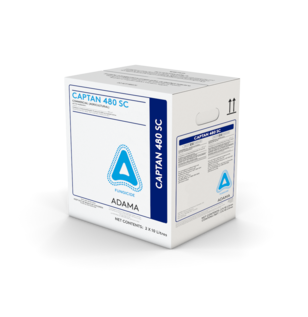VANTANA™
This Group 29 fungicide is a very important resistance management tool with activity on the hardest-to-control fungal diseases.

KEY BENEFITS
- Resistance Management Tool
- Can be used on multiple crops
- Broad-spectrum disease control
- Multiple rates for precise control
General Info
HOW IT WORKS
VANTANA™ works by inhibiting fungal adenosine triphosphate (ATP) production in the mitochondria (impairing energy production). Active on a wide range of diseases, VANTANA™ is a protective fungicide that inhibits the germination of fungal spores.
Packaging
- Case: 2 x 10 L jugs
Application Rates & Acres Treated
- Rate: 162 – 907 ml/ ac
- Acres Treated: 11 – 62 ac/jug
Water Volume
- Ground: Varies with the crop. Refer to the label for
more details. - Aerial: Minimum of 18.2 L/ac
Rainfastness
- Avoid application when heavy rain is forecast.
Application Rates & Timing
Apples
| Diseases |
Rate: ml/ac (ml/ha) |
Timing |
|---|---|---|
| Cedar apple rust | 304–405 (750–1,000) |
Apply to foliage as a preventative measure before disease occurs. |
| Black rot*, Brooks spot*, Quince rust* | 405 (1,000) |
Begin applications before disease occurs, and continue on a 7-day schedule |
* suppression
Always read and follow label directions.
Blueberries (lowbush)
| Diseases |
Rate: ml/ac (ml/ha) |
Timing |
|---|---|---|
| Valdensinia leaf spot | 162–324 (400–800) |
Begin applications at early bloom or at first symptoms in fruiting fields and at an equivalent time in sprout fields. |
Always read and follow label directions.
Blueberries (highbush, lowbush). Currant, Elderberry, Gooseberry, Huckleberry
| Crop | Disease |
Rate: ml/ac (ml/ha) |
Timing |
|---|---|---|---|
| Blueberries (highbush, lowbush) | Suppression: Mummyberry, Phomopsis fruit rots and fruit anthracnose | 907 (2,240) |
Begin applications at bud break and repeat on a 7 to 10 day interval to petal fall. |
| Currant, Elderberry, Gooseberry, Huckleberry | Fruit anthracnose* |
*suppression
Always read and follow label directions.
Bulb Onion
| Disease |
Rate: ml/ac (ml/ha) |
Timing |
|---|---|---|
| Purple blotch Botrytis leaf blight | 469 (1 16) (584 g) |
Begin applications when conditions are favourable for disease development or when first disease symptoms appear |
Always read and follow label directions.
Dry-shelled beans, Edible-podded legume vegetables (except pea)
| Crop | Disease |
Rate: ml/ac (ml/ac) |
Timing |
|---|---|---|---|
| Dry-shelled beans | White mould | 243–405 (600 –1,000) |
10 to 30% bloom If needed, a second application may be applied 7–10 days later (for white mould) or 10-14 days later (for anthracnose). |
| Anthracnose | |||
| Edible-podded legume vegetables (except pea) | White mould | First bloom to 10% bloom |
Always read and follow label directions.
Ginseng
| Disease |
Rate: ml/ac (ml/ha) |
Timing |
|---|---|---|
| Rhizoctonia root rot | 486 (1,200) | Begin at seed then continue on a 14-day interval. |
| Alternaria blight, Botrytis blight | Begin when the disease first appears or when conditions are favourable for disease development. Repeat applications on a 7- to 14-day interval. |
Always read and follow label directions.
Potatoes
| Disease |
Rate: ml/ac (ml/ha) |
Timing |
|---|---|---|
| Late blight | 162 (400) |
When plants are 15-20 cm tall or when conditions are favorable |
| White mould | 162 – 242 (400 – 600) |
At full bloom |
Soybeans
| Disease |
Rate: ml/ac (ml/ha) |
Timing |
|---|---|---|
| White mould | 356 – 473 (880–1,170) |
Begin applications at the R1 (early bloom) to R2 (full bloom) stage of development and, if needed, again 10- to 14-days later at early pod formation (R3). |
| White mould* | 178 (440) |
*Suppression
Always read and follow label directions.
Leafy Brassica Greens (Crop Subgroup 5B) — Pre-transplant treatment; Head and Stem Brassica (Crop Subgroup 5A), Leafy Brassica Greens (Crop Subgroup 5B) — Transplant treatment
| Disease |
Rate: ml/ac (ml/ha) |
Timing |
|---|---|---|
| Clubroot | 2.9 L | Pre-transplant |
| Mix 50 ml with water to make a 100 L solution. | At transplant Apply 100 mL of solution per plant immediately after transplanting |
Always read and follow label directions.



